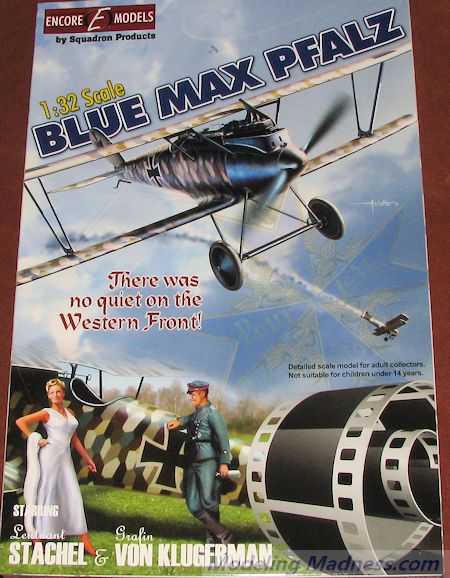
Encore 1/32 Blue Max Pfalz
| KIT #: | EC 32004 |
| PRICE: | $44.34 on sale here. ($69.99 SRP) |
| DECALS: | Three options |
| REVIEWER: | Scott Van Aken |
| NOTES: | Includes resin and photo etch parts |

| HISTORY |
Prior to World War I, Pfalz Flugzeugwerke produced Morane-Saulnier monoplane designs under license. These aircraft entered military service as the Pfalz A- and E-series. In September 1916, Pfalz began producing the first of 20 Roland D.I and 200 Roland D.II fighters under license.
In November 1916, Pfalz hired Rudolph Gehringer from Flugzeugbau Friedrichshafen GmbH. As Pfalz’s new chief engineer, Gehringer immediately commenced work on an original fighter design. The resulting D.III emerged in April 1917. Like the Rolands, the D.III used a plywood monocoque fuselage. Two layers of thin plywood strips were placed over a mold to form one half of a fuselage shell. The fuselage halves were then glued together, covered with a layer of fabric, and doped. This Wickelrumpf method gave the fuselage great strength, light weight, and smooth contours compared to conventional construction techniques. However, it also proved to be more labor intensive and expensive. Furthermore, the D.III fuselage was prone to twisting or warping from side to side as it aged, a defect variously attributed to the use of insufficiently seasoned wood or to moisture absorption in damp conditions.
The wings were of conventional construction, with a flush Teves und Braun radiator offset to the right side of the upper wing. The ailerons were of wooden construction, rather than the more conventional steel tube construction. The horizontal stabilizer had an inverted airfoil section, which facilitated dive recovery and permitted the use of an unbalanced elevator.
The Idflieg found the prototype promising. It directed Pfalz to halt production of the Roland D.III and to complete the balance of the contract, 70 aircraft, to the new design. After a Typenprüfung (type test) at Adlershof in May, the Idflieg ordered various modifications, including an enlarged rudder and horn-balanced ailerons. In June 1917, Pfalz received a second order for 300 aircraft.
| THE KIT |
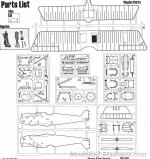 For those unfamiliar with the philosophy behind Encore kits, they get basic model parts of current kits (in this case from Roden), and add photo etch and resin parts along with much better decals. So they have done with this latest release of the Pfalz D.III.
For those unfamiliar with the philosophy behind Encore kits, they get basic model parts of current kits (in this case from Roden), and add photo etch and resin parts along with much better decals. So they have done with this latest release of the Pfalz D.III.
In this case, they have chosen to market the kit as the plane of Lt. Stachel from the 1966 movie 'The Blue Max'. This movie was adapted from the book of the same name by Jack D. Hunter which first came out in 1964. Those who have seen the movie know that most of the German and British planes were converted Tiger Moths and Stampes, but two Pf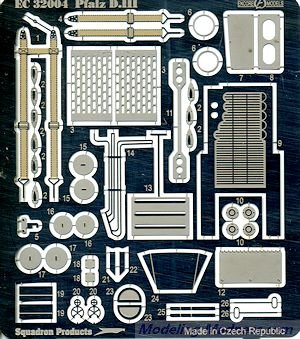 alz D.III replicas were built by two different companies for use in the movie as were a pair of Fokker Dr.Is. The MS.230 used near the end of the film was supposed to represent a Fokker D.VIII.
alz D.III replicas were built by two different companies for use in the movie as were a pair of Fokker Dr.Is. The MS.230 used near the end of the film was supposed to represent a Fokker D.VIII.
The reason I bring this up is because the kit allows you to build three different versions of the plane. One as done for the movie, one as portrayed in the book (the literary version) and one that is historically accurate.
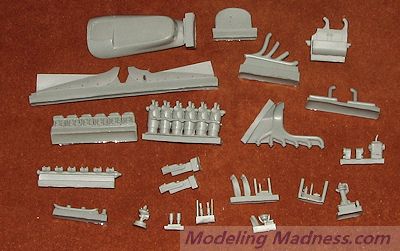 Roden's Pfalz D.III was released several years ago and was well received by the buying public. The kit includes a full engine, two different props and a very nicely done interior. Encore has added to this a nicely done photo etch fret that includes such things as a seat harness, cooling jackets for the machine guns as well as various bits for removable access panels and hatches. In addition, there are quite a few superbly molded resin bits. These include a resin upper cowling (actually there are two of them), resin pistons for the engine, gun receivers, exhaust, as well as coolant pipes from the radiator and other smaller detail bits.
Roden's Pfalz D.III was released several years ago and was well received by the buying public. The kit includes a full engine, two different props and a very nicely done interior. Encore has added to this a nicely done photo etch fret that includes such things as a seat harness, cooling jackets for the machine guns as well as various bits for removable access panels and hatches. In addition, there are quite a few superbly molded resin bits. These include a resin upper cowling (actually there are two of them), resin pistons for the engine, gun receivers, exhaust, as well as coolant pipes from the radiator and other smaller detail bits.
Because of differences in the three versions, the instructions are specific as to what parts go with which versions. What I like is that the instructions are divided into different sections for the movie, literary, and historical builds. This makes things so much easier, though it does mean that the builder will have to decide from the very first which version he wants to do. A result of these choices is that certain parts will not be needed. There are also quite a few modifications that the builder will need to do such as removing or filling in details and cutting parts (such as r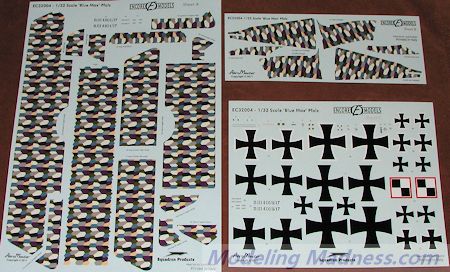 emoving the cylinders from the plastic engine). One will also need to be handy with plastic rod for the gun barrels. The instructions also provide a full rigging diagram for each version.
emoving the cylinders from the plastic engine). One will also need to be handy with plastic rod for the gun barrels. The instructions also provide a full rigging diagram for each version.
 The decals supplied with the kit are superb and quite extensive. This Pfalz was covered with lozenge for the movie version on the fuselage and all upper surfaces. The other two are in an overall grey with the historical version having the markings of Lt. Heinrich Arntzen of Jasta 15 in 1918. Also included in the kit are two resin figures. One is Lt. Stachel in his Prussian cavalry uniform. The other is Countess von Klugermann in a slinky white dress.
The decals supplied with the kit are superb and quite extensive. This Pfalz was covered with lozenge for the movie version on the fuselage and all upper surfaces. The other two are in an overall grey with the historical version having the markings of Lt. Heinrich Arntzen of Jasta 15 in 1918. Also included in the kit are two resin figures. One is Lt. Stachel in his Prussian cavalry uniform. The other is Countess von Klugermann in a slinky white dress.
| CONCLUSIONS |
What you end up with is an excellent kit that includes all the bells and whistles. Encore starts with a quality kit and things just get better from there. No need to get any aftermarket for this one as all is included in the box. The instructions really are superlative and one wishes all model companies would follow this example. The use of color in them really helps out. Having high quality decals as well as the two figures only adds to the value of this one.
| REFERENCES |
June 2014
Thanks to Squadron Products for the preview kit. You can get yours todayat this link.
If you would like your product reviewed fairly and fairly quickly, please contactthe editor or see other details in the